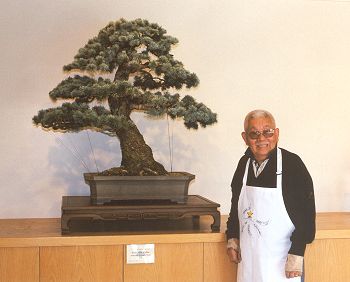
Gimpo, 1973
Details and larger version
For about twenty years, John moved this Blue Atlas cedar between the ground and a container. When trees are field-grown, the increase in trunk size accelerates, more branches develop, and scars heal faster. But to attain the quality of shibui (hidden beauty), a tree needs to grow more slowly in a pot. This is also the best time to focus upon branch refinement and ramification. Eventually, John was satisfied with its size, so the tree found a permanent home in a pot.

John loved the silvery-blue foliage of the cedar, and he thought the powerful branches gave the impression of the fabulous wings of a super bird. Therefore, gimpo – Japanese for “silver phoenix” – seemed the perfect name for such a majestic tree. A bonsai master from Japan complimented the tree, stating that he had never seen such a clear, nice five-needle pine in his life. When informed that this was a cedar and not a pine, the bonsai master offered that in every category, the Blue Atlas cedar was superior to the five-needle pine.
The tree had two potential fronts, but on one side there was a big scar where a large branch had been removed. For many years, the front of the tree was chosen to hide the scar in the back. But eventually John decided that the back must become the front. His reasoning: “a scar will heal, but a bad front will never heal.”

[ Top of page | Go back | Go forward | "Profiles in Bonsai" contents | Site contents | Home | ]